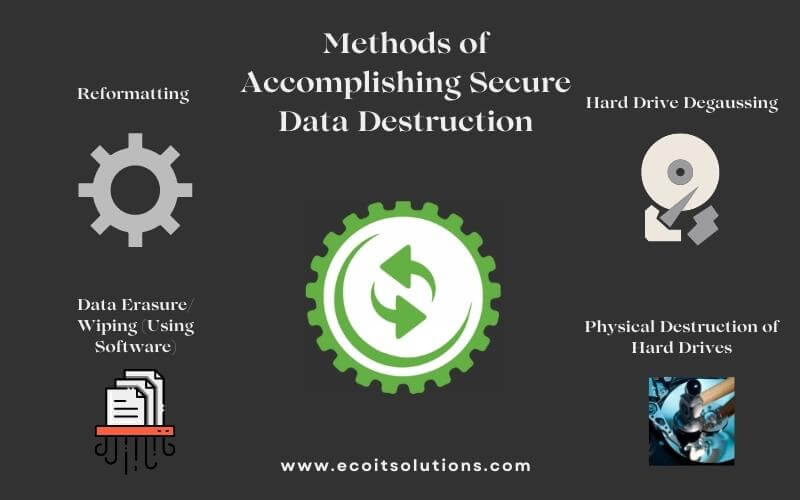The Significance of Effective Data Destruction Practices in Shielding Sensitive Details and Ensuring Computer System Safety
In an age where information violations are progressively typical, the relevance of reliable information devastation methods can not be overstated. Executing robust information damage approaches not just alleviates these dangers but additionally straightens with lawful compliance requirements, making certain that companies promote their credibility and foster customer trust.
Recognizing Data Destruction
Recognizing information destruction is crucial in today's electronic landscape, where sensitive details can conveniently be jeopardized. Effective information damage involves not just removing documents yet making sure that information is irretrievable with thorough methods. This process is important for organizations that handle personal customer info, intellectual property, or internal documents, as any kind of breach can cause severe monetary and reputational repercussions.
Data destruction includes different techniques, consisting of shredding physical media, degaussing magnetic storage space gadgets, and using software-based solutions that overwrite information multiple times. Each technique offers a certain function and should line up with the sensitivity of the details being dealt with. Physical devastation is commonly chosen for hard drives including highly private data, while software approaches may be sufficient for less delicate details.
Moreover, sticking to industry standards and policies, such as the General Data Security Regulation (GDPR) or the Medical Insurance Mobility and Liability Act (HIPAA), is vital for compliance and to minimize lawful dangers. Organizations must develop a durable data damage plan, train workers on finest methods, and on a regular basis investigate their treatments to guarantee that all delicate details is disposed of safely and successfully.
Dangers of Inadequate Practices
Insufficient data destruction techniques reveal companies to substantial dangers that can have far-ranging consequences. When sensitive information is not appropriately thrown away, it remains prone to unauthorized access, which can lead to information breaches and identification theft. Such cases not only endanger the protection of individuals however additionally tarnish the company's track record, resulting in a loss of customer depend on and potential monetary repercussions.
In addition, regulative compliance is significantly rigid in several markets. Failing to follow information devastation regulations can result in significant fines and legal actions against companies. These charges can draw away and stress monetary resources attention from core business procedures.
On top of that, the abuse of recurring data can lead to copyright theft or corporate espionage, jeopardizing competitive advantages (data destruction). The impact of poor information damage prolongs past instant financial losses; it can likewise result in long-lasting damage to brand name honesty and market setting

Organizations should identify that data safety and security is not solely concerning protecting against violations; it also incorporates the liable administration of data throughout its lifecycle. Ignoring efficient data devastation procedures can have devastating ramifications, underscoring the requirement for robust procedures to alleviate these risks.
Ideal Practices for Information Damage
Executing reliable data damage practices is crucial for guarding delicate info and maintaining conformity with regulatory criteria. Organizations ought to take on a multi-faceted technique to make sure that information is irretrievable, thus preventing unauthorized access and possible breaches.
First, data ought to be classified based upon level of sensitivity, allowing companies to apply suitable damage techniques customized to the level of threat. For digital data, utilizing software-based data-wiping tools that conform with sector criteria can efficiently overwrite existing data. Physical devastation methods, hop over to these guys such as shredding or degaussing, are important for tools that store sensitive info, ensuring complete eradication.
Establishing useful source a clear information retention plan is crucial, outlining for how long various kinds of details ought to be preserved before damage. Regular audits of data storage systems are also required to determine unneeded or out-of-date information requiring elimination.
In addition, training employees on the significance of data destruction and the particular procedures to follow fosters a society of safety and security within the company. Keeping paperwork of data devastation refines supplies responsibility and sustains compliance with internal plans and external regulations. By sticking to these finest techniques, organizations can considerably alleviate the threats linked with data exposure.
Legal and Conformity Factors To Consider

Failure to abide by these regulations can result in extreme penalties, consisting of substantial penalties and reputational damages. Organizations has to carry out a durable information damage plan that lines up with these lawful frameworks and provides clear standards on the appropriate methods of data disposal, whether physical shredding or electronic wiping.
Additionally, keeping documentation of information destruction activities is vital for showing conformity throughout audits or inspections. By prioritizing lawful and compliance considerations, organizations can enhance their information security posture and foster depend on with clients and stakeholders, inevitably adding to an extra protected information management atmosphere.
Advantages of Effective Information Destruction
Efficient data devastation methods expand beyond simple conformity; they use significant advantages to companies that prioritize them. By guaranteeing that delicate information is irretrievably damaged, organizations alleviate the risk of data violations and the prospective monetary repercussions connected with them. This positive method not just safeguards versus unauthorized accessibility but also boosts the overall credibility of the organization in the eyes of clients and stakeholders.
Carrying out robust data damage techniques, such as physical destruction of storage tools or sophisticated information wiping strategies, adds to the conditioning of a company's cybersecurity posture. data destruction. It minimizes the chance of copyright theft and safeguards proprietary details, consequently maintaining an one-upmanship in the marketplace

Conclusion
To conclude, efficient information devastation techniques are crucial for protecting delicate information and improving total computer protection. By implementing detailed approaches such as degaussing, software application, and shredding overwriting, organizations can alleviate the risks related to unapproved access and data violations. Adherence to regulatory standards, including GDPR and HIPAA, additional enhances conformity and protects versus legal consequences. Ultimately, a commitment to robust information destruction methods fosters a society of obligation, thus reinforcing a company's cybersecurity posture and maintaining client trust.

Comments on “The Impact of Effective Data Destruction on Cyber Security Danger Administration”